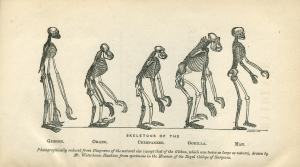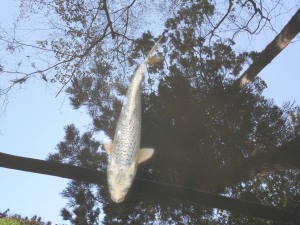In my last post about evolution I may have not been quite on target on a couple of things.
First, I don’t want to set up natural selection as a straw man. If you look at a modern textbook on evolution you will find many much more subtle mechanisms for evolution in which natural selection may play a small or even no role at all (genetic drift, for example). Selection is still generally thought to be a final arbiter in most scenarios, but that is a given. If some change, no matter the mechanism, doesn’t allow for successful multigenerational reproduction at higher rate than what is already in play, of course it won’t result in change, and change, movement, transmuting energy into new form and function, is what evolution, is what life in the realm of the six senses, is all about. It’s such a given, so inherent in its formulation, that I referred to it as a tautology, out of respect, not as a criticism.
Second, I may have opened up a sense of awe and wonder of the “Gaps.” Like a God of the gaps, it is weak to the point of meaninglessness. Wonder and awe, deep inspiration, spiritual insight, samadhi, are not made more or less authentic and part of your life by gaps in some other view or metaphysical stance, including current scientific data or dogma. It is not a matter of using the gaps in science to create openings for anything else or to justify your practice or beliefs. Of course you can fit whatever fantasy or delusion you care for in those gaps, and fundamentalists do, but hopefully your world view is more coherent and doesn’t rely on gaps.
Science will never have no gaps. A gap is important in directing where scientists need to look to learn more. However, our approach to measuring the universe through extensions of our six senses is finite, internal to what we are measuring, and so has limits. The limits of science will likely include our finite monkey brain with a certain number of synapses that evolved to survive in a given time and space or our technology which doesn’t have the oomph to explore the realms we dream up with our math and the implications of current scientific understanding of basic, fundamental physics. Many gaps, of course, will be filled IF our species survives and thrives. Science has a really good track record of surprising gap filling!
I watched a wonderful lecture series on particle physics from the Great Courses called “The Theory of Everything” given by Don Lincoln. If you want to know what is current thinking in physics, including where the gaps are, this is the series for you. But that isn’t its real strength. If you want to see how a working experimental physicist approaches the matter of matter and energy, this is the best out there. Now, it doesn’t go as much as you might like into the gee whiz stuff of quantum (a bit of course; has to!) and makes no real effort at “deeper meaning,” but that’s what I loved about it. Just what scientists think they know and what they think they don’t know about particles and forces.
One thing he points out: we can already describe the transformations of energy in all the realm of the six senses by a series of equations that would fit on a tee shirt. Problem is they are disconnected and don’t fit well together and require constants, numbers empirically derived, that we have no theoretical basis for. Lanza and Berman also discuss this in “Biocentrism”. A real gap in physics that these are experimentally derived, often approximated, and not derived from some single number and first principles. A very recent book that goes into that in detail about this is Lewis and Barnes “A Fortunate Universe Life in a Finely Tuned universe.” While I liked their detailed exposition of the situation, I wasn’t as enthralled by the philosophical discussion at the end; too dualistic.
There are gaps that I think will remain in science. One is any ultimate “explanation,” mostly because explanation past a mechanistic story or mathematical description will always be an attempt to take observations and fit them into a more sophisticated story that works on our human scale and perspective. Why should that work? We are primates! Why should the Universe, Truth, be primate friendly, understandable and graspable in its entirety by primate intellectual constructions?
Buddha famously warned against speculative metaphysics. He seems to have said something like: yeah I know a bunch of stuff, and so can you, but don’t get distracted. Take care of your world on fire. There will be understanding, but don’t get greedy, first things first.
Another gap I believe will be a scientific theory of consciousness. Lets say scientists can show exactly the neurologic correlates of consciousness to an exquisite and intellectually satisfying level of detail, way beyond what is known now. That will happen to one degree or another and is happening now in neuroscience. I am not as enthralled with neuroscience as an adjunct to my practice as some seem to be in the Buddhist community. I am currently enjoying “Behave” by a primatologist Robert Sapolsky. But, while I’m not through yet, this is not a metaphysical book, it explores how we function as human primates, as the subtitle says “the biology of humans at our best and worst.” Interesting stuff, so far a great read, but not about consciousness per se, but about our contingent biologic programming. Anyway, even if our scientific understanding of consciousness goes deep, deep, deep into quantum effects on the mind and in neurology and complex brain level activity, and grasps the role in our consciousness of inputs from the endocrine system, the immune system and the gut etc., and shows how it all fits together, will that be any different from describing the science of light (energy, electromagnetic waves, photons and quantum field theory) and perception (eyes, optic nerve, brain pathways) to a blind person and expect them to experience the color yellow? Heck, we sighted people with the usual kinds of photoreceptors (i.e. not color blind) don’t have yellow receptors in our eyes, yet we see yellow, as a story, a projection.
The universe is energy transformations. That changes in, and perhaps defines, our experience of time and space. That is what evolution is and it is of the nature of movement. The question is: what is the basis of these transformations, and whether consciousness, Mind, is fundamental, foundational? The most given of givens. The irreducible.
So, let there be no straw men or spirituality, awe or consciousness of the gaps. We don’t need no stinkin’ gaps or straw men to bolster our practice, to be compassionate, for samadhi, to be.







